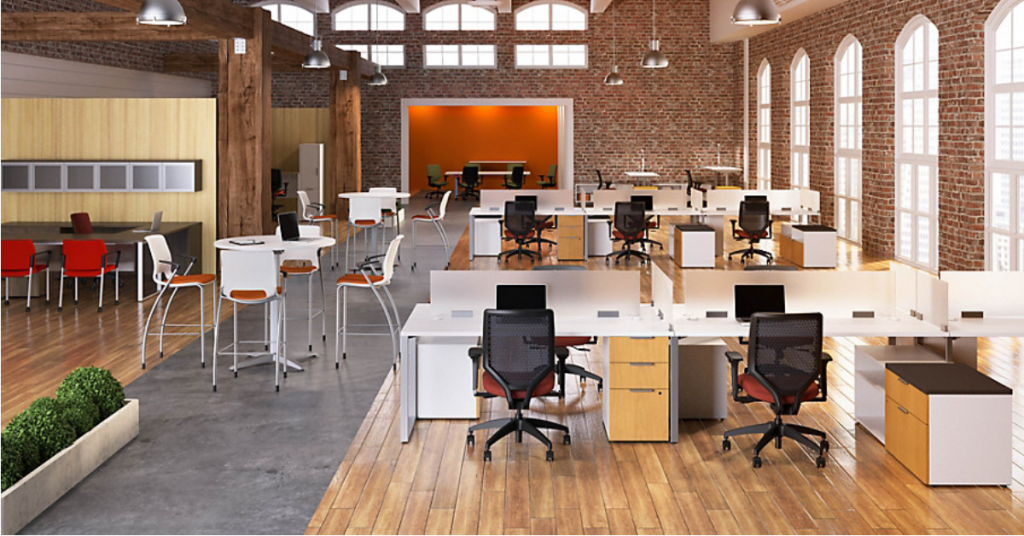Incorporating Universal Design Into Your Office Space
October 29, 2019Universal design is less about décor and more about inclusion.
In today’s modern workspaces, the diversity of your employees and customers requires you to create widely accessible office spaces that give everyone a safe, positive experience, regardless of age or disability.
This piece explains universal design, identifies why it’s important in an office, and guides you through the process of selecting the right office furniture that can help support universal design floor plans while meeting the needs of your growing, diverse workforce.
What Is Universal Design?
Universal design (UD) is the design of environments (such as workspaces), buildings, and products that are accessible to everyone, including those with and without disabilities or other conditions. In other words, UD caters to everyone with the philosophy to create a space that’s suitable for your entire team or client base!
Universal design is all around us. Think about sliding glass doors at medical buildings or department stores. How about side-by-side escalators and stairs, with a nearby elevator? You’ve probably never thought twice about these features. Yet these options, part of universal design, meet everyone’s needs at once.
UD incorporates seven principles for broad accessibility, including:
- Low physical effort: These are components that require little or no effort to utilize. Ramps for wheelchair users or those that struggle with steps are equally suitable for those who can take stairs.
- Size and space: Hallways, entrance ways and common areas should be wide enough to maneuver around.
- Flexibility in use: The workplace should be designed to meet the needs of people with a wide variety of abilities and preferences. This covers all bases, from those with physical disabilities to people who are recovering from injuries and people of varying physical abilities.
Why is Universal Design Important in the Workplace?
The rate of those with disabilities in the workforce is steadily increasing. As awareness grows, the definition of disability is changing. Disabilities may include physical conditions, such as those with limited physical abilities (for example, someone in a wheelchair); neurodevelopmental conditions such as autism and adhd; vision- and hearing-impaired.
But universal design goes far beyond these disabilities to create comfortable and safe workspaces for those with “invisible” conditions, such as mental health disorders; learning disabilities; and people with temporary medical conditions.
If the idea of universal design is intimidating, don’t worry! You don’t need to retrofit your entire office with expensive upgrades or renovations. Nor do you have to compromise on aesthetics. Furniture suppliers recognize the need for UD and provide products that meet multiple needs while looking modern and on-trend.
“Inclusive” is Not a Buzzword!
While you may hear about inclusiveness a lot these days, it’s really about the idea that people with different needs shouldn’t be excluded from being productive members of the workforce.
If you design it, they will work! Don’t miss out on hard-working and talented team members or potential clients because your workspace isn’t adequately equipped.
How to Incorporate Office Furniture to Support Universal Design Floor Plans
Chairs: Ergonomics is huge in the workplace! Choose a variety of chairs that are adjustable, supportive and comfortable for your team and clients.
Desks: Again, variety is key. Provide desks without chairs or desks and tables that fit wheelchairs. Sit-to-stand desks are very popular and can meet a multitude of needs!
Storage: Mile high filing cabinets aren’t safe or practical! Use alternatives like credenzas, short bookshelves, low cabinets, and hanging mini pedestal file cabinets.
Open Spaces: The modern workplace is moving towards an open floor plan. Choose furniture such as work stations or tables. Provide a casual area with couches, chairs and stools as an alternative to the traditional cubicle.
Other Universal Design Considerations
Lighting: Full spectrum or circadian lighting, in addition to lighting workspaces or desks, helps mimic natural light and is much more soothing than harsh fluorescent lighting.
Noise Control: Whether team members and clients have sensory issues or need quiet to concentrate on intense projects, controlling the noise in your office is important! Evaluate the acoustics—ceiling tiles and carpets that absorb sound make a huge difference when it comes to distractive noise.
**Bonus Tip** If possible, dedicate a small room for sensory or brain breaks. A quiet, softly lit room accented with plants or a fish tank can offer all your team members a place to steal away for a few minutes to get away from the noisy hustle-and-bustle of the office.
Other UD features like safety alarms with flashing lights, large-print instructions, handrails, flat panel light switches and door levers all contribute to safety for everyone!
Resources for Hiring Employees with Disabilities
- Learn about the U.S. Department of Labor’s (DOL) hiring initiatives for disabled workers.
- The Job Accommodation Network (JAN) offers free advice on providing workplace accommodations for those with disabilities.
- Americans with Disabilities Act
- Read Disability Accomodation Tips for Small Businesses to learn about inexpensive and free accommodations, tax cuts and more!
Office environments are changing to meet the growing needs of a new kind of workforce. With safe, comfortable and healthy workplace components, you can create a space that allows everyone, no matter what their unique needs, to thrive and excel!
The experts at Nolt’s Furniture are happy to walk you through the process of universal design. Stop by our showroom today!

